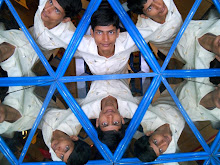Bracketing Exposures
Most modern DSLR cameras and some top end compact cameras have the facility to set up a series of shots taken at different exposures, this is called bracketing. In the diagram on the right you can see the display from my Canon 7D set to take three different exposures, one at the correct exposure according to the meter reading, one at one f-stop under and one at one f-stop over. These settings will apply to the next three shots I take. The first shot will be the 'correct' exposure, followed by the under exposure and lastly the over exposure.
Use Bracketing in conjunction with the high speed drive mode.
Whilst 'auto bracketing' remains set (until I cancel it) the camera will cycle through the same three exposure settings so, if my 'drive' is set to single shot, I must remember to take three shots of each scene. However, if I set the 'drive' to 'continuous shooting' mode, it will take three shots (at the different exposures) and stop. This seems a much better way to work, especially on the high speed drive setting, I can take three exposures in rapid succession, so the shots will be almost identical and I don't have to remember how many shots I have taken.
When to bracket exposures
Bracketing is very useful when the lighting is difficult, the background keeps changing or there is too much contrast. You then have a set of pictures to choose from when you get home. You can even choose bits from different pictures if you are a keen Photoshopper.
When you are photographing a nice peaceful landscape you have time to study the pictures and, more importantly, the histograms, and take another shot if necessary. Conversely, when you are shooting sports, there is no time for bracketing as every second, or even fraction of a second, counts (The observant among you will have noticed that I could not possibly have used bracketing on the shots on the left as there is no difference between them. I 'faked' the differences in Adobe Camera Raw just to show the type of effect you get from bracketing). However, when you are taking pictures of people or things moving at normal speed, pictures of the kids playing for instance, then bracketing with a fast 'drive' is not a bad idea.
I have many otherwise good photos that have been spoiled by a burnt out highlight on the face. These would have benefited from a shorter exposure. Likewise I have pictures that came out too dark and, although they can be saved to some extent by careful editing, they lack the range of tones you would get in a properly exposed photo.
How wide should the bracket be?
In the old days of film, the rule of thumb was that, if you were using negative film, a whole f-stop between exposures would be OK. If you were using slide film 1/2 stop or 1/3 stop increments would be better.
The same really applies with digital exposures, if you are shooting RAW then one stop would be a good gap. If you are shooting jpegs then you need to make the gap between exposures closer as there is less opportunity to correct problems in post processing. If you look at the diagram at the top of the page you will see that I have set the gap at one f-stop as I always shoot RAW files.
Using bracketing and Exposure compensation together
The center of the bracket does not necessarily have to be in the middle of the exposure dial. It is possible to apply exposure compensation and add bracketing at the same time.
So you could have the 'over exposure' on the center line of the scale. This would give you a 'correct' exposure, one stop under and two stops under. Or you could set the 'under exposure' on the center line and have one stop and two stops over.
The latter would have been the way to go for the picture above as the 'correct' exposure according to the meter produced the top frame. As I said in my article on photographing in the snow, all skiing shots should be over exposed by at least one stop because of the light background. Here, although we are not photographing against the snow, the sun is behind the subject fooling the meter into under exposing the shot.
So, although automatic metering is very good in most circumstances, you can see here a couple of ways that it can easily be fooled. If you are in any doubt as to whether the camera will produce the best possible exposure, try bracketing to give you
Saturday, December 4, 2010
Subscribe to:
Post Comments (Atom)




0 comments:
Post a Comment